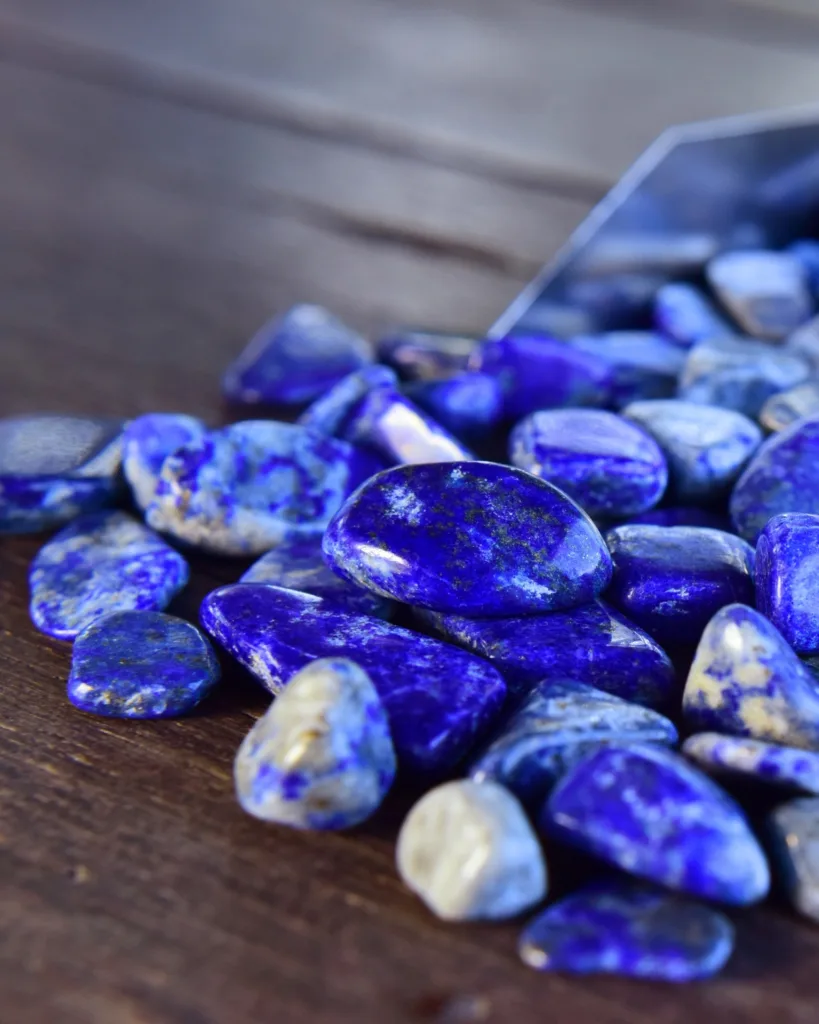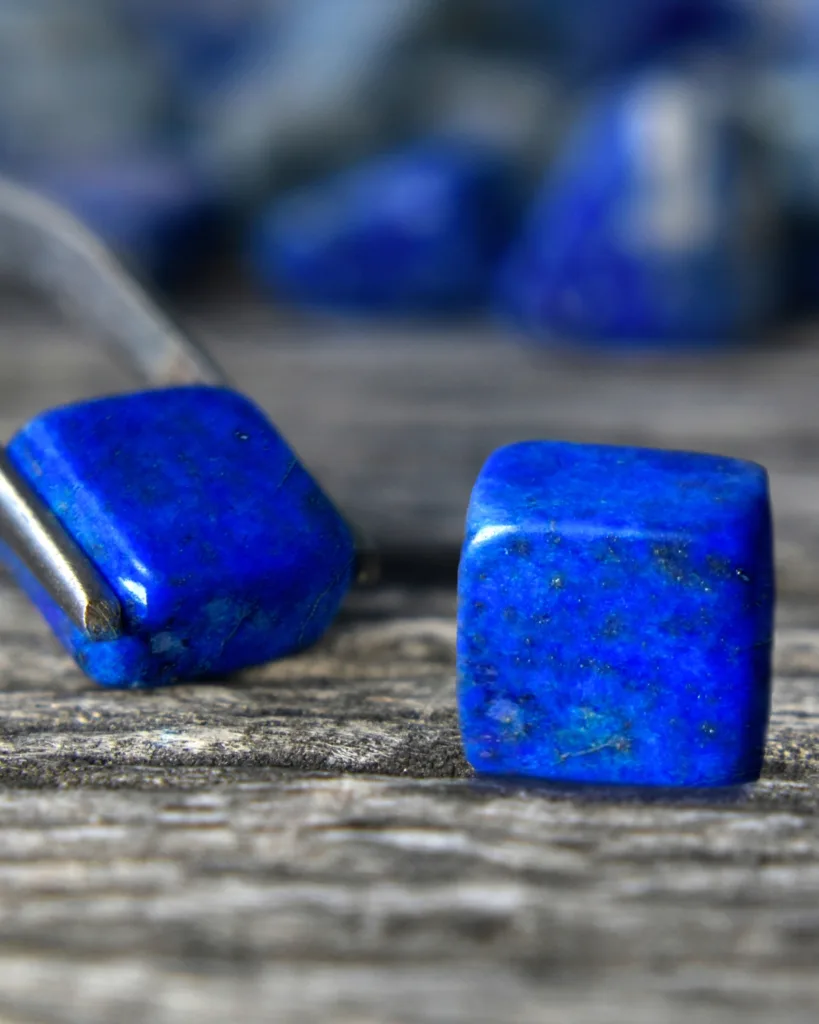Meaning of Lapis Lazuli – Lapis Lazuli is a beautiful gemstone that has captivated people for centuries with its deep blue color and striking appearance. In addition to its aesthetic appeal, Lapis Lazuli gemstone also holds significant meaning and properties that make it a sought-after stone in the world of gemstones and crystal healing.

Meaning of Lapis Lazuli
Lapis Lazuli derives its name from the Latin word “lapis” meaning stone, and the Persian word “lazhward” meaning blue. This gemstone has been highly valued throughout history and is often associated with royalty, spirituality, and wisdom.
Known as the stone of truth and enlightenment, Lapis Lazuli is believed to enhance intellectual abilities, stimulate the desire for knowledge, and promote self-awareness. It is also said to encourage self-expression and creativity, making it a popular choice among artists, writers, and musicians.
Properties of Lapis Lazuli Gemstone
Lapis Lazuli stone is composed mainly of the mineral lazurite, along with other minerals such as calcite and pyrite. Its deep blue color, often with golden flecks, is what makes it so visually striking.

One of the key properties of Lapis Lazuli is its ability to activate the third eye chakra, which is associated with intuition, insight, and spiritual awareness. By stimulating this energy center, Lapis Lazuli is believed to enhance one’s psychic abilities and facilitate spiritual growth.
Another notable property of Lapis Lazuli stone is its association with the throat chakra, which governs communication and self-expression. This gemstone is believed to promote honest and open communication, both with oneself and with others. It is said to help overcome shyness, encourage self-confidence, and facilitate effective expression of thoughts and feelings.
Lapis Lazuli is also known for its protective properties. It is believed to shield the wearer from negative energies and psychic attacks, while promoting inner peace and harmony. It is often used as a talisman for spiritual protection and as a tool for meditation and spiritual practices.
Uses of Lapis Lazuli
Due to its striking appearance and rich symbolism, Lapis Lazuli has been used for various purposes throughout history. In ancient Egypt, it was highly prized and used in the creation of jewelry, amulets, and burial masks. It was believed to bring protection, good fortune, and eternal life.
In addition to its use in jewelry, Lapis Lazuli has also been used in art and decoration. Its vibrant blue color has been used to create pigments for painting and dyeing, most notably in the famous ultramarine color used by Renaissance artists.
In the realm of crystal healing, Lapis Lazuli is often used for its calming and balancing properties. It is believed to help relieve stress, anxiety, and insomnia, while promoting emotional healing and inner peace. It is also said to enhance clarity of thought and improve focus and concentration.
How to Care for Lapis Lazuli
Like all gemstones, Lapis Lazuli requires proper care to maintain its beauty and energy. It is a relatively soft stone, with a Mohs hardness rating of 5 to 5.5, which means it can be easily scratched or damaged.
To keep your Lapis Lazuli gemstone in optimal condition, it is recommended to avoid exposing it to harsh chemicals, extreme temperatures, and direct sunlight. Clean it gently with a soft cloth and store it in a separate pouch or box to prevent scratching or damage from other jewelry.
The History of Lapis Lazuli Gemstone
Lapis Lazuli is a stunning gemstone that has captivated people for centuries with its deep blue color and unique properties. This gemstone has a rich history that dates back thousands of years, making it a fascinating subject to explore. The origins of Lapis Lazuli can be traced back to ancient civilizations such as Mesopotamia, Egypt, and Persia.

It was highly prized by these cultures for its vibrant blue color, which was associated with royalty and divinity. In fact, Lapis Lazuli was often used to create intricate jewelry and decorative objects for pharaohs, kings, and emperors. One of the most famous uses of Lapis Lazuli can be seen in the art of ancient Egypt.
The Egyptians believed that this gemstone had protective and healing properties, and it was often used in amulets and talismans. The famous burial mask of Tutankhamun is adorned with Lapis Lazuli, showcasing its importance in Egyptian culture. Lapis Lazuli also played a significant role in the ancient trade routes of the Silk Road.
It was highly valued by merchants and was often transported across vast distances to reach markets in Europe, Asia, and the Middle East. The gemstone’s scarcity and beauty made it a symbol of wealth and luxury. In addition to its aesthetic appeal, Lapis Lazuli was also believed to have metaphysical properties. It was thought to enhance spiritual growth, promote inner peace, and stimulate intellectual abilities. Many ancient civilizations used Lapis Lazuli in their spiritual practices and rituals.
Today, Lapis Lazuli continues to be cherished for its beauty and symbolism. It is used in jewelry, sculptures, and even in the field of alternative medicine. Its deep blue color and unique patterns make it a sought-after gemstone by collectors and enthusiasts alike.
The history of Lapis Lazuli is a testament to its enduring allure and significance. From ancient civilizations to modern times, this gemstone has captivated people with its beauty and mystique. Its rich history and cultural significance make it a gemstone worth exploring and appreciating.
Final Thoughts
Lapis Lazuli is a gemstone that not only mesmerizes with its stunning appearance but also holds significant meaning and properties. Whether you are drawn to its deep blue color, its spiritual associations, or its calming and balancing effects, Lapis Lazuli is a gemstone that can bring beauty, wisdom, and healing into your life.
Learn about the Meaning of Labradorite gemstone.
Disclaimer: All metaphysical, benefit information or healing properties stated in this article are collected from various sources. This information is provided as a guide and is not meant or intended to treat or to be used for any medical conditions. Gemma Rayne does not guarantee the validity of the information and statements made herein.





